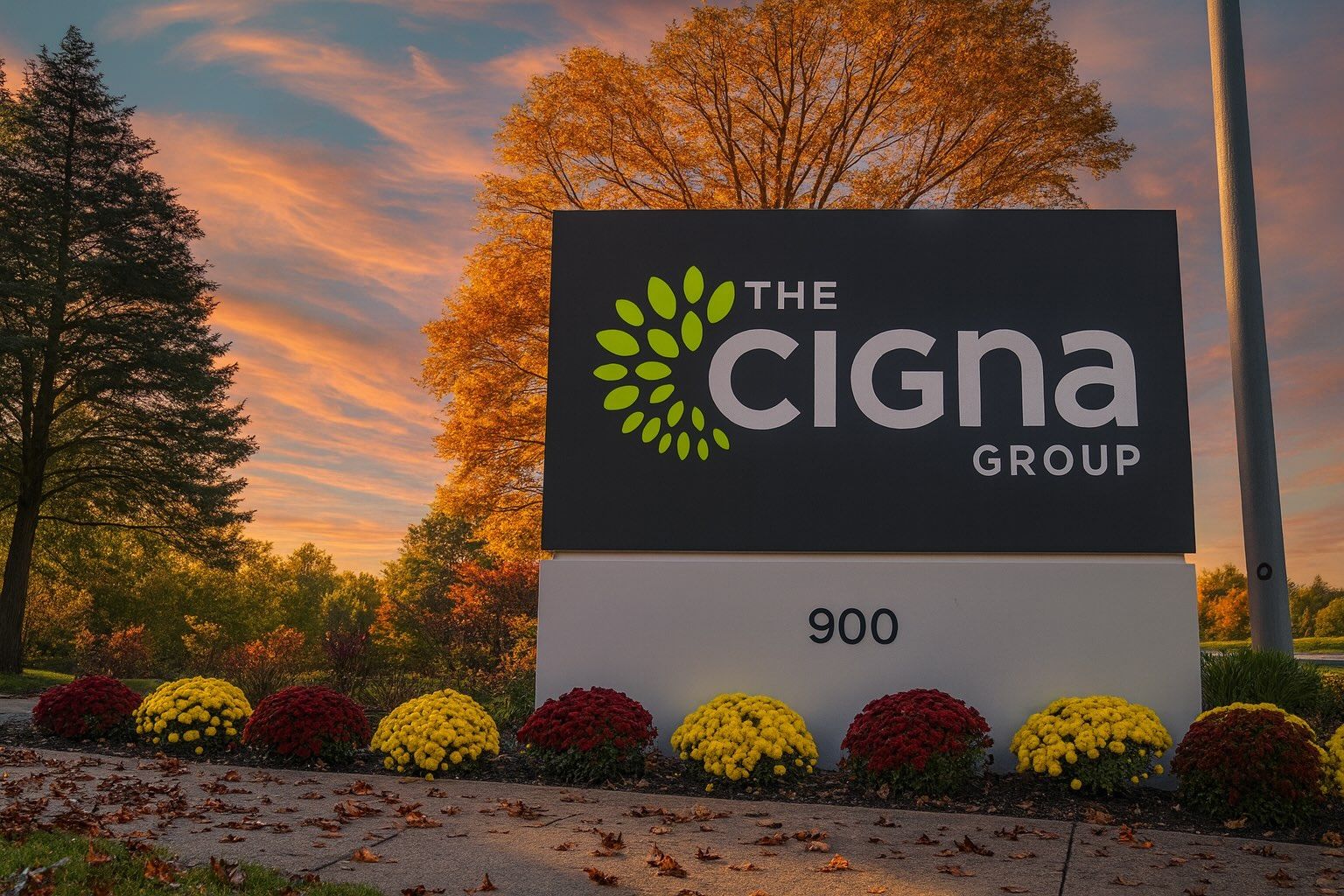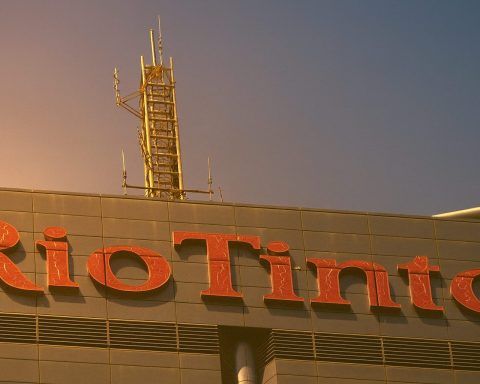- Stock Price: CI closed around $299.12 on Oct 29, 2025, down about 3% from the prior week [1]. On Oct 30 premarket it traded near $303 [2]. The stock’s 52-week range is $257–$350 [3].
- Recent Trend: CI’s shares have eased from summer highs near $350, slipping below $300 late October [4] as investors digest mixed sector news and rising healthcare costs.
- Q3 Results: Cigna reported strong third-quarter 2025 results (released Oct 30). Total revenue rose ~10% to $69.7 billion, net income was $1.868 billion ($6.98/share) vs $739 million a year ago, and adjusted income from operations was $2.096 billion ($7.83/share), above analysts’ $7.64 forecast [5] [6]. The company reaffirmed its full-year adjusted EPS outlook of at least $29.60 [7].
- Corporate Developments: Cigna announced a new “rebate-free” pharmacy benefit model to cut costs and boost transparency [8]. In early September, its Evernorth unit agreed to invest $3.5 billion in specialty-pharmacy firm Shields Health to expand its drug distribution business [9]. (In March 2025, Cigna completed the sale of its Medicare unit to Health Care Service Corp., but will continue serving those members via Evernorth services [10].)
- Analyst Outlook: The consensus among analysts is bullish. The average 12-month price target is about $370–$377, implying ~23–26% upside [11] [12]. Wall Street’s consensus rating is “Moderate Buy/Strong Buy” with most analysts expecting further gains.
- Sector & Macro Context: Cigna’s results came as U.S. markets were mixed after the Federal Reserve cut rates on Oct 29 (S&P 500 flat, Nasdaq up 0.6%) [13]. Like other insurers, Cigna is navigating higher medical costs and policy uncertainty (e.g. tax credits for ACA plans). UnitedHealth and Elevance (Anthem) also beat Q3 forecasts but warned of Medicaid cost pressures [14] [15].
CI Stock Price and Recent Trend
Cigna’s stock has pulled back modestly in late October after a strong run earlier in the year. According to market data, CI closed at $299.12 on Oct 29, 2025, down about 3% from the previous close [16]. The dip followed weakness in broader managed-care stocks amid concerns about healthcare costs and policy. In pre-market trading Oct 30, CI rebounded to about $303 (up ~1.3%) [17]. Over the past year, CI shares have traded between roughly $257 and $350 [18], reflecting volatility in the insurance sector.
Despite the pullback, Cigna’s valuation metrics remain attractive: at ~16x forward earnings, it still trades well below historical levels. Analysts note that a year-long surge (partly driven by specialty pharmacy profits) left CI ripe for profit-taking. As Morningstar’s Julie Utterback observed, Cigna “maintained the status quo from a 2025 guidance perspective, which is probably what is keeping shares flat” [19]. In other words, the company stuck to its outlook, so the stock is trading largely on fundamentals rather than any new surprises.
Third-Quarter 2025 Results Exceed Expectations
On Oct 30, Cigna reported blowout Q3 results that beat Wall Street forecasts. Revenue rose 9–10% year-over-year to $69.75 billion [20], and adjusted operating profit was $2.096 billion ($7.83 per share), topping the $7.64 consensus [21]. Net income of $1.868 billion (about $6.98/share) compared to just $739 million ($2.63) in Q3 2024 [22]. These strong numbers were driven largely by Cigna’s Evernorth health services unit (pharmacy benefits and specialty pharmacy), where adjusted revenue jumped ~15% to $60.39 billion [23].
CEO David Cordani highlighted the broad strength of the business and growth initiatives in the earnings release. Cordani said “our strong quarterly results reflect the breadth of our businesses and focused execution on our growth strategy” [24]. He specifically pointed to the new rebate-free pharmacy model announced just before earnings, noting this “market-defining” plan will “lower costs and enhance transparency” for patients [25]. (Under this plan, Cigna will eliminate most drug rebates in its commercial plans by 2027, putting more savings at the point of purchase [26].)
Notably, Cigna also reaffirmed its full-year 2025 outlook despite the results beat [27]. The company maintains it will deliver at least $29.60 in adjusted EPS for the year (analysts’ consensus was $29.63) [28]. This suggests management is confident in continued strength. Cigna did warn that costs in its “stop-loss” insurance products were higher (medical loss ratio 84.8% vs 82.8% year-ago [29]), but said these were in line with expectations. In short, the earnings release conveyed that Cigna is growing profitably and executing on its strategy, and the stock reacted modestly upward as investors took in the news [30].
Analyst Reactions and Quotes
Wall Street was generally upbeat on Cigna’s results. The stock rose about 1.3% in premarket trading on Oct 30 [31]. Analysts point to the continuing momentum in Evernorth as a key strength. Evernorth’s growth — especially in specialty pharmacy (Accredo) — helped offset pressure in Cigna’s core health-plan side [32].
Julie Utterback at Morningstar noted that Cigna’s reaffirmed guidance kept expectations steady, saying, “Cigna maintained the status quo from a 2025 guidance perspective, which is probably what is keeping shares flat…” [33]. In other words, by delivering exactly what it promised, Cigna avoided upsetting investors. Many analysts were also encouraged by Cordani’s comments on healthcare challenges: by rolling out the new pharmacy model and staking out a transparent pricing stance, Cigna is trying to address one of the industry’s biggest issues.
Across the industry, other experts saw parallel trends. For example, UnitedHealth (UNH) also beat Q3 estimates and even raised its 2025 profit forecast, though its shares remained roughly unchanged [34]. Gabelli Funds portfolio manager Daniel Barasa called UnitedHealth’s results “highly encouraging” given the EPS raise [35], noting a return to beating estimates. Elevance Health (formerly Anthem) similarly beat Q3 forecasts but warned that higher Medicaid costs would weigh into 2026 [36]. As these peers show, the sector is benefiting from easing COVID-era disruptions but still grappling with state and federal healthcare cost issues.
On balance, Cigna’s performance compares well. The company’s nearly 10% year-over-year revenue growth and solid profit margins have impressed analysts. Stock consensus remains bullish: MarketBeat data shows a “Moderate Buy” consensus, with an average 12-month price target of about $370 (roughly 24% above recent levels) [37]. StockAnalysis.com similarly notes analysts have a “Strong Buy” consensus and see roughly $377 as the fair value [38].
Outlook and Future Performance
Looking ahead, most analysts see further upside for CI stock. The industry’s tailwinds — aging population, rising healthcare usage, and ongoing demand for pharmacy services — should drive solid earnings. Cigna’s strategy of expanding specialty pharmacy and transparent pricing could boost its growth profile. “Investors will look for comments on 2026 outlook,” Utterback added [39]. Management has scheduled an earnings call to discuss the results, and commentary there will be closely watched.
Technical analysts also point out that, trading around $300, CI is much closer to its 52-week low than to its high. If the broader healthcare rally continues, many argue Cigna could reclaim past peaks. The company’s dividend yield (~2.0%) adds income appeal as well. One caveat is the still-high expense of stop-loss and Medicaid plans, which may keep margins under pressure in the near term. But Cigna has repeatedly reiterated its 2025 EPS floor of $29.60 [40] despite those costs, suggesting confidence in handling them.
Healthcare Sector and Macro Context
Cigna’s story is set against a busy healthcare landscape. Government healthcare spending is rising: a recent Reuters report noted employer health premiums jumped 6% in 2025 to nearly $27,000 per family [41]. Regulators are also pushing for more prescription drug pricing reforms nationwide. Cigna’s new rebate-free approach is part of this trend (Bloomberg and the WSJ have run stories on Cigna’s plan [42] [43]).
Meanwhile, broader markets have been reacting to Federal Reserve moves. On Oct 29, 2025, the Fed cut interest rates by 0.25% to a 3.75–4.00% range, but signaled any further cuts aren’t guaranteed [44]. U.S. stock indexes ended mixed that day: the Dow was down ~0.2%, the S&P 500 was flat, and the Nasdaq was slightly higher [45]. Healthcare stocks like Cigna often move with these cycles: a lower interest rate environment can boost insurance companies’ borrowing costs and investment income, while also supporting stock valuations. The ongoing partial U.S. government shutdown has had limited immediate impact on insurers, though it adds general uncertainty [46].
In comparison to peers, Cigna’s recent focus on niche pharmacy may give it an edge. UnitedHealth’s Optum and Elevance’s medical businesses have had trouble with high-cost patient loads and new drug therapies, issues Cigna is managing partly through partnerships and technology. All told, analysts expect the insurance sector to be modestly positive on the horizon, especially if the economy remains stable and healthcare reforms gradually improve pricing transparency.
Conclusion: The Cigna Group has delivered a convincing quarter, combining top-line growth with strategic initiatives to reduce drug costs. While its stock dipped slightly after the results, analysts remain upbeat. As one market research site notes, Cigna’s average price targets imply a 20–25% upside from here [47] [48]. With a solid balance sheet, diversified business segments, and a commitment to innovation (e.g. the new pharmacy model), Cigna appears well-positioned for continued growth. Investors will be watching closely as management provides more color on 2026 guidance, but for now the mood is cautiously optimistic that CI’s stock may be poised for another leg up.
Sources: Company filings and press releases [49] [50]; Reuters, Nasdaq, and Investing.com news articles [51] [52] [53] [54] [55] [56]; analyst consensus data [57] [58]; market data sites [59] [60].
References
1. stockanalysis.com, 2. www.reuters.com, 3. stockanalysis.com, 4. stockanalysis.com, 5. www.prnewswire.com, 6. www.reuters.com, 7. www.reuters.com, 8. www.prnewswire.com, 9. www.healthleadersmedia.com, 10. www.hcsc.com, 11. stockanalysis.com, 12. www.marketbeat.com, 13. www.investopedia.com, 14. www.reuters.com, 15. www.reuters.com, 16. stockanalysis.com, 17. www.reuters.com, 18. stockanalysis.com, 19. www.reuters.com, 20. www.nasdaq.com, 21. www.reuters.com, 22. www.nasdaq.com, 23. www.reuters.com, 24. www.prnewswire.com, 25. www.prnewswire.com, 26. www.reuters.com, 27. www.reuters.com, 28. www.reuters.com, 29. www.reuters.com, 30. www.reuters.com, 31. www.reuters.com, 32. www.reuters.com, 33. www.reuters.com, 34. www.reuters.com, 35. www.reuters.com, 36. www.reuters.com, 37. www.marketbeat.com, 38. stockanalysis.com, 39. www.reuters.com, 40. www.reuters.com, 41. stockanalysis.com, 42. stockanalysis.com, 43. stockanalysis.com, 44. www.investopedia.com, 45. www.investopedia.com, 46. stockanalysis.com, 47. www.marketbeat.com, 48. stockanalysis.com, 49. www.prnewswire.com, 50. www.hcsc.com, 51. www.reuters.com, 52. www.reuters.com, 53. www.reuters.com, 54. www.reuters.com, 55. www.nasdaq.com, 56. www.investopedia.com, 57. stockanalysis.com, 58. www.marketbeat.com, 59. stockanalysis.com, 60. stockanalysis.com









